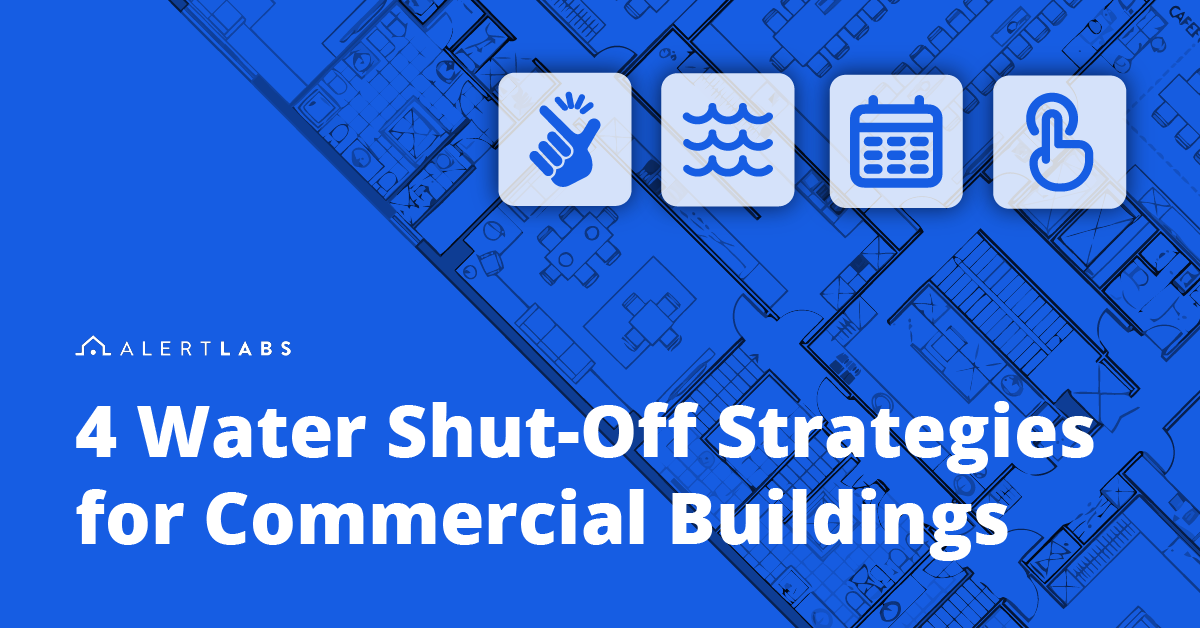Temperature Sensors for Detecting Frozen Pipes in Commercial Buildings

Commercial buildings that are located in places where freezing temperatures are a common (or even not so common) occurrence need protection against water damage due to burst pipes, melting snow and other winter-related risks. The best strategy requires a two-pronged approach: (1) old fashioned preparation (2) smart sensors that detect temperature.
Preparing commercial buildings for winter
Before the colder weather hits, and during the winter months, consider doing the following to reduce the risk of water-related winter property damage:
- Assess and repair vulnerable parts of the building by updating aging infrastructure or completing outstanding maintenance projects
- Evaluate the risk of damage by being aware of how different building materials react to water and moisture: wood soaks up water and has to be completely replaced after major water damage events, concrete erodes, and metal rusts
- Identify low-lying areas inside and outside the building where water can pool
- Schedule snow removal from sloped roofs to prevent ice damming
In addition to doing general winter preparation, special attention should be paid to preventing a major source of water damage in the winter: frozen pipes that burst.

Prevent pipes from freezing
Pipes can freeze at 32°F (0°C), but the risk is greatest when outdoor temperatures are 20°F, or lower, for 6 consecutive hours. The following steps can help minimize the risk of damage:
- Insulate exposed pipes, especially ones along exterior walls
- Keep the indoor temperature at 55°F (12.5°C) or higher, especially in high-risk areas of the building. The extra cost of the heating bill will more than offset the expense of a major water damage repair
- Increase air circulation throughout the building by leaving interior doors open – in particular, the doors to housing for pipes
Note: some experts suggest leaving faucets open at a drip but this method could cause water damage and may be impractical in buildings with complex water systems.
For more info, see article: Burst Frozen Pipes - How to Prepare & What to Do
The Need for Smart Temperature Detection
Winterizing buildings and taking steps to prevent frozen pipes can reduce the risk of property damage. But, many of the steps listed above may be impractical or cost-prohibitive for commercial buildings, e.g., leaving interior doors open, or upgrading aging infrastructure.
Temperature detecting technology is the next line of defense providing 24/7 remote monitoring with emergency text, email and push notification alerts.
What are Smart Temperature Sensors?
Smart temperature sensors are devices about the size of a hockey puck that use an internet connection to send alerts to building teams when temperatures rise above or fall below a specified temperature threshold. They run on batteries or are plugged-in and the better models also detect water leaks or humidity.

Choosing the right sensor
Most of the temperature detection devices on the market are not designed for commercial applications. Businesses require temperature monitoring devices that are scalable, reliable and adaptable to use cases that are specific to each building.
Here’s a list of features to consider when comparing commercial temperature sensors.

Battery-operation
Exposed pipes are located in areas that may not have AC power, so battery-operated devices provide greater flexibility when it comes to installation. The best sensors provide low-battery notifications and offer battery life of 2 years or more.
Alerts: delivery and information
How alerts are delivered and the information they contain are key factors. A system that includes text, email, push notifications, and phone calls ensures that building teams get the message. Receiving instant alerts containing information about the location of the temperature problem, updates on the power status of the building and being able to specify the thresholds for temperature alerts are also essential features of a commercial-grade temperature detection solution.

Integrations
The best temperature monitoring solution offers an API that integrates with existing BMS/BAS and is part of a larger ecosystem of smart building sensors that detect the following problems: water flow analytics and leak detection, water leak detection, automatic water shut-off, humidity detection, and accessory cables for monitoring larger areas or extreme temperatures.
Building Insights
Historical records of all temperature data with auto-generated reports and AI machine learning analytics help teams prevent costly damage.
Network connection
Temperature detection systems that do not require wired-networks, WiFi or a local internet connection allow teams to receive alerts during power loss. Insurance companies also prefer cellular-connected sensors as they are more reliable - the last time your home internet went down, you were probably able to make a call with your smartphone.
Quick Installation
Outfitting a 250,000 sq. ft. building with smart temperature sensors should take about one (1) day. Installation should be quick and as non-intrusive as possible. This is especially important for businesses looking to scale to multiple buildings in their portfolio.
Company reputation
Sensors that are made in North America and backed by stable parent company help ensure that the technology inside the sensors will continue to work and be supported long into the future.
Preparing commercial properties for cold weather conditions by employing a strategy that includes both traditional maintenance methods and smart temperature devices will greatly reduce the risk of property damage and business interruption not only during colder months but all year round.




